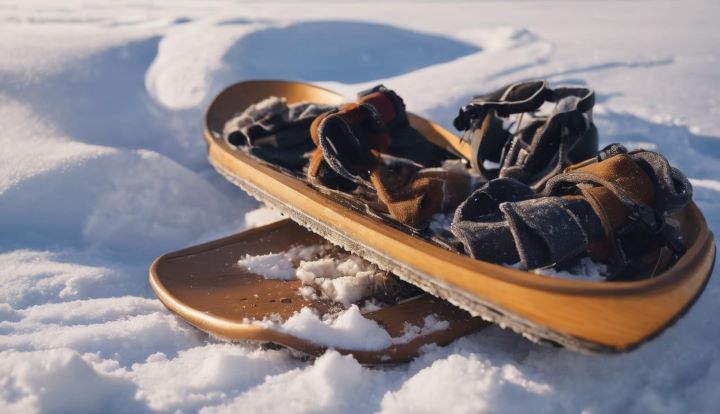Snowshoes, those remarkable contraptions that allow us to walk on snow with ease, have been used by humans for thousands of years. From ancient civilizations to modern adventurers, these ingenious tools have stood the test of time. But have you ever wondered how snowshoes actually work? In this article, we will delve into the mechanics behind these fascinating devices and explore the science that enables us to traverse snowy landscapes effortlessly.
Thank you for reading this post, don't forget to subscribe!At first glance, snowshoes may appear simple, just a wooden or metal frame with a webbed surface, but their design is anything but ordinary. The underlying principle behind snowshoes lies in their ability to distribute weight over a larger surface area, preventing the wearer from sinking into the snow. By spreading the pressure exerted by each step, snowshoes effectively mimic the natural walking motion on solid ground. But it is not only about floating on the surface; the intricate webbing of the shoes manages to grip the snow, providing stability and traction. So, let us embark on this journey of discovery, unraveling the mystery of how these marvelous tools enable us to conquer the winter wonderland.
How do snowshoes work?
Snowshoes work by distributing your weight and preventing you from sinking into deep snow. The large surface area of the snowshoe helps to increase flotation, allowing you to walk on top of the snow. The frame and bindings of the snowshoe provide stability and control. The crampons on the bottom of the snowshoe provide traction on icy surfaces. With snowshoes, you can enjoy winter hikes and explore snowy terrains easily.

How Do Snowshoes Work
Snowshoes are essential tools for traversing snowy terrains. They allow individuals to walk on top of deep snow without sinking, making it easier to navigate through winter landscapes. Understanding how snowshoes work can help you make the most of your winter adventures.
In this article, we will explore the mechanics behind snowshoes and provide a step-by-step guide on how to use them effectively.
Understanding the Design
Snowshoes are designed to distribute your weight over a larger surface area, preventing you from sinking into the snow. They consist of a frame, bindings, and a deck.
The frame is typically made of lightweight and durable materials such as aluminum or composite materials. It provides structure and support to the snowshoe. The bindings secure your boots to the snowshoes, allowing you to move with ease. The deck, usually made of durable fabric or synthetic materials, acts as a platform that keeps you afloat on the snow.
Step-by-Step Guide to Using Snowshoes
Now that you understand the basic design of snowshoes, let’s dive into how to use them effectively:
1. Choose the Right Snowshoes
Before heading out, make sure you have the right snowshoes for the type of terrain and conditions you’ll be facing. Consider factors such as your weight, the type of snow, and the length of your trek.
Consult with a knowledgeable professional or do thorough research to ensure you select the appropriate snowshoes for your needs.
2. Wear the Right Footwear
Proper footwear is crucial when using snowshoes. Wear insulated and waterproof boots that provide warmth and protection against the cold and wet conditions. Make sure your boots are compatible with the snowshoe bindings.
It’s also recommended to wear moisture-wicking socks to keep your feet dry and comfortable throughout your adventure.
3. Adjust the Bindings
Each time you use snowshoes, adjust the bindings according to the size of your boots. Properly fitted bindings ensure stability and prevent any discomfort or potential injuries.
Follow the manufacturer’s instructions or seek guidance to ensure your bindings are adjusted correctly.
4. Master Your Technique
Walking with snowshoes is slightly different from walking without them. Take some time to practice your technique before venturing into challenging terrains.
Keep your steps wider and slower than usual, allowing the snowshoes to distribute your weight effectively. Use your poles, if available, for better balance and stability.
5. Be Mindful of Weight Distribution
When traversing slopes or uneven terrain, be mindful of your weight distribution. Lean slightly forward to maintain balance and prevent slipping or tripping.
Use your poles strategically to provide additional support and stability when needed.
6. Take Care of Your Snowshoes
After each use, clean off any snow or ice from your snowshoes. Store them in a cool and dry place to prevent damage or deterioration.
Regularly inspect your snowshoes for any signs of wear or damage and address them promptly. This will ensure their longevity and optimal performance.
Conclusion
Understanding how snowshoes work and following proper techniques can greatly enhance your winter adventures. By distributing your weight effectively and using the right equipment, you’ll be able to explore snowy landscapes with ease and confidence.
Frequently Asked Questions
Snowshoes are essential equipment for walking or hiking in snowy conditions. They help distribute your weight over a larger surface area, preventing you from sinking into the snow. Here are some commonly asked questions about how snowshoes work.
How do snowshoes work?
Snowshoes work by providing flotation and traction on snow. The large surface area of the snowshoe spreads your weight over a larger area, preventing you from sinking into the snow. This allows you to walk on top of the snow instead of sinking into it. The frame of the snowshoe is typically made of lightweight materials such as aluminum or plastic, which helps to reduce the overall weight of the snowshoe.
Additionally, snowshoes have crampons or metal teeth on the underside that provide traction on icy or packed snow. These crampons grip the snow, allowing you to maintain stability and prevent slipping. The combination of flotation and traction makes it easier to walk or hike in snowy conditions without sinking or sliding.
What are the different types of snowshoes?
There are several different types of snowshoes available, each designed for specific activities and terrains. Some common types include:
1. Recreational snowshoes: These are suitable for beginners and casual snowshoeing on flat to rolling terrain.
2. Backcountry snowshoes: These are designed for more rugged terrain and steep slopes. They often have features such as heel lifts for climbing uphill and aggressive crampons for better traction.
3. Running snowshoes: These are lightweight and designed for running or fast-paced activities on packed snow or groomed trails.
4. Mountaineering snowshoes: These are built for extreme conditions and can handle deep snow and icy terrain. They typically have larger crampons and more durable construction.
Do I need special boots to use snowshoes?
While you don’t necessarily need special boots, it is recommended to wear boots that provide good ankle support and insulation. Waterproof or water-resistant boots are also beneficial to keep your feet dry in wet or snowy conditions. It’s important to ensure that your boots can fit securely into the bindings of the snowshoes to prevent any discomfort or instability while walking.
Additionally, wearing thick, moisture-wicking socks can help keep your feet warm and dry during your snowshoeing adventures. It’s always a good idea to choose boots and socks that are appropriate for the temperature and conditions you’ll be encountering.
How should I choose the right size of snowshoes?
The size of snowshoes you choose depends on your weight, the weight of any additional gear you’ll be carrying, and the type of snow conditions you’ll be encountering. The general rule of thumb is that the larger the surface area of the snowshoe, the more flotation it provides. A larger snowshoe is ideal for deep snow, while a smaller snowshoe is suitable for packed or icy terrain.
It’s also important to consider the recommended weight range provided by the manufacturer. Make sure to select a snowshoe that falls within your weight range to ensure optimal performance and flotation. Trying on different sizes and consulting with knowledgeable staff at outdoor stores can help you determine the right size of snowshoes for your needs.
Can I use snowshoes for hiking in the mountains?
Yes, snowshoes are commonly used for hiking in the mountains during winter months. They provide the necessary flotation and traction to navigate snowy and icy terrain. However, it’s important to choose snowshoes that are specifically designed for mountaineering or backcountry use if you plan to tackle steep slopes or more challenging conditions.
Additionally, it’s crucial to have the appropriate knowledge and skills for hiking in mountainous terrain, especially during winter. It’s recommended to consult with local experts or experienced mountaineers to ensure you have the necessary equipment and are aware of any potential risks or hazards.

In conclusion, understanding how snowshoes work is essential for anyone venturing into snowy terrains. The ingenious design and functionality of snowshoes allow individuals to traverse through deep snow with ease and efficiency. By distributing the weight over a larger surface area, snowshoes prevent sinking, enabling individuals to walk and explore without getting stuck in the snow. This simple yet effective mechanism has been used for centuries by various cultures around the world, and continues to be a valuable tool for outdoor enthusiasts, hikers, and winter sports enthusiasts alike.
Moreover, the modern advancements in snowshoe technology have further enhanced their performance and versatility. With the introduction of lightweight materials, adjustable bindings, and innovative traction systems, snowshoes have become even more efficient and comfortable. Whether one is hiking, snowshoeing, or participating in winter mountaineering, the proper use of snowshoes ensures safety and enhances the overall experience in snowy environments. So, next time you find yourself in a winter wonderland, don’t forget to strap on a pair of snowshoes and embark on a thrilling adventure while staying on top of the snow!

